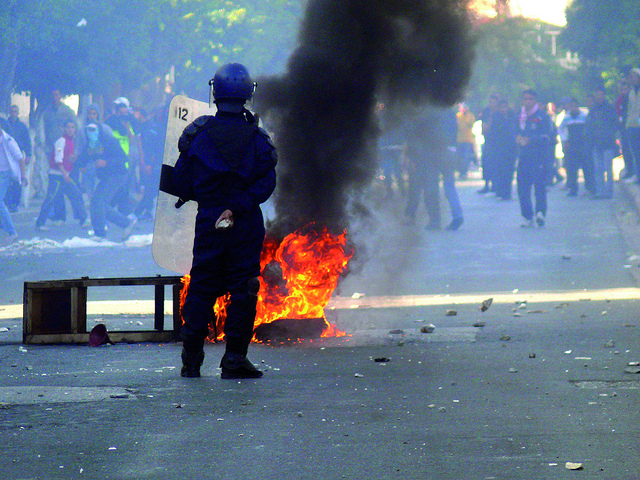Podcast: Play in new window | Download
Subscribe: RSS

Food riots erupted across North Africa in 2011 — this one in Algeria in January — after prices spiked. It’s about to happen again. (Photo by Magharebia/Flickr)
Some poet invented the name “Arab Spring” as a label for the tsunami of public desperation that last year took down the governments of Tunisia, Egypt and Libya. Poets and Pollyannas saw the events as an upwelling of love for democracy. Realists related them to the spike in world food prices that threatened the survival of whole populations and made them desperate for change — any change. Now, thanks in large part to events unfolding in the American heartland, get ready for another, worse, spike.
We are running out of superlatives with which to describe the Mid- and Southwestern drought and its effect on this year’s corn and soybean crops. According to this week’s USDA crop update the situation during the previous seven days went from “critical” to, um, worse than that. The drought is the worst in half a century. Of the largest US acreage ever planted in corn (industrial agriculture was crowing about that just a couple of months ago), only one-quarter is still in good condition. (Modest rainfall in drought-stricken areas early this week provided mostly emotional relief; the drought is forecast to continue unabated through October.)
One guesstimate about how this is going to play out, from some financial analysts in Australia, is that the US corn harvest will be about 60 million metric tons short of expectations. For perspective, consider; Argentina, the number two corn-producing country in the world, puts about 25 million tonnes in the crib. In addition, a heat wave across southern Europe into Ukraine is wilting the corn crop that typically provides 16 per cent of world supplies.
The notion that the shortfalls in the harvest are driving the price increases misses a critical point. Commodity prices, followed quickly by food prices, are heading skyward now, months before the crop is harvested and measured. How can that be? For the same reason that crude oil price increases produce instant gas-pump price increases, months before the crude gets to the pump. Speculation.
According to researchers from the New England Complex Systems Institute, commodity speculation — bets placed by hedge funds and investment banks — wildly amplify clues and predictions about the future state of the markets. Using models that include the effects of speculation — whose very existence is strenuously denied by financiers and industrial ag tycoons — the Institute sees the threat of “global catastrophe driven by a speculator amplified food price bubble.”
Stories that have appeared thus far in the popular American media are pointing out such effects of the drought as an increase, sometime next year, of perhaps 15 cents in the price of a loaf of bread. In a country where the average consumer spends well under 10 per cent of her income on food, this is hardly an alarm bell. For hundreds of thousands of people around the world, however, another spike in food prices is a death sentence. And the notion that only their end of the boat is sinking is bogus.
The more unstable the world, the more failed states and refugees, the more wars for resources, the more dangerous life becomes for us all. Consider, for example, what would happen if the American Fall should do what the Arab Spring failed to do — ignite the population of Saudi Arabia. Good luck rowing your end of the boat away from that one.
[See also: Hunger Games in the Heartland; UN, Oxfam Reports: Brace for Impact; From American Spring to American Fall]
I’ve taken the liberty of quoting a small piece of this in a post I have coming out on change on the 2nd August. But the reason for leaving this comment is just to say how wonderful your choice of words – such a pleasure to read good prose. “Poets and Pollyannas saw the events as an upwelling of love for democracy.” being just one example.
Thank you very much. I see that you, sir, are no slouch in the prose department. I am going to link to your lovely, contemplative site, Learning from Dogs, in Our Web Community.